
Denmark - private rail companies
For a full scale picture, please click on the picture shown !
Arriva
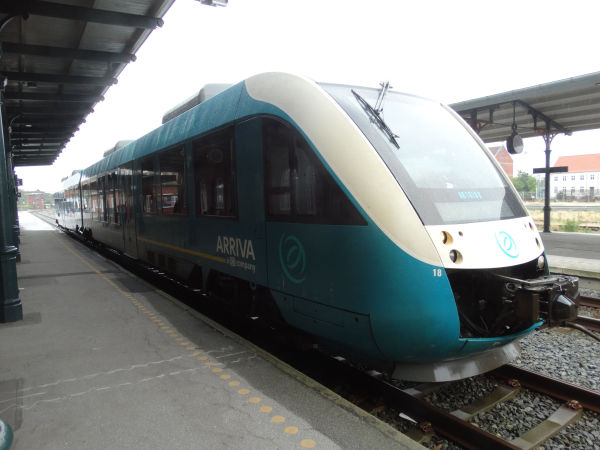
Arriva is originally a British company, which won in public tenderings some of the local and regional
train routes in Jutland. Originally Arriva rented old railbuses from DSB, but proceeded then to buy
new rolling stock. Today most of Arriva's traffic in Denmark is run by these Alstom made trains of the
type Lint. Arriva has for some years now been a daughter company of the German DB. Already since 2016
there have been rumours circulating that DB would sell all of Arriva, but so far it hasn't happened
(though DB has sold pieces of it, for example the Swedish Arriva to VR of Finland).
Picture from Esbjerg station 8.7.2016.
by Ilkka Siissalo.
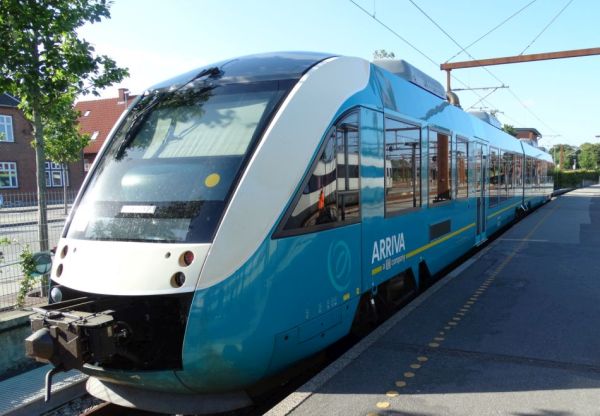
Another one of Arriva's Alstom Lint trains.
Picture from Esbjerg 6.7.2022 by Ilkka Siissalo.
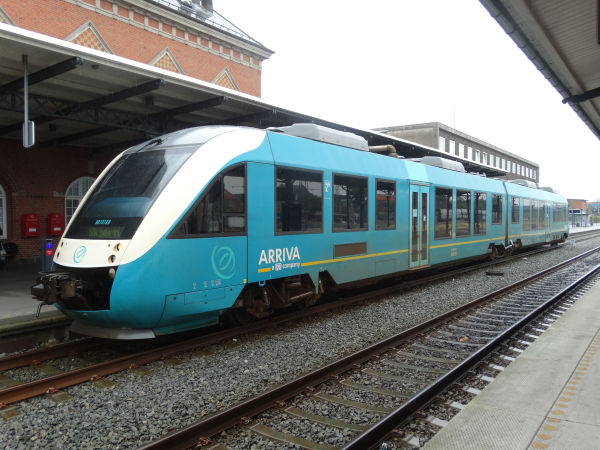
Another view of an Arriva Lint at Esbjerg station 8.7.2016.
Picture by Ilkka Siissalo.
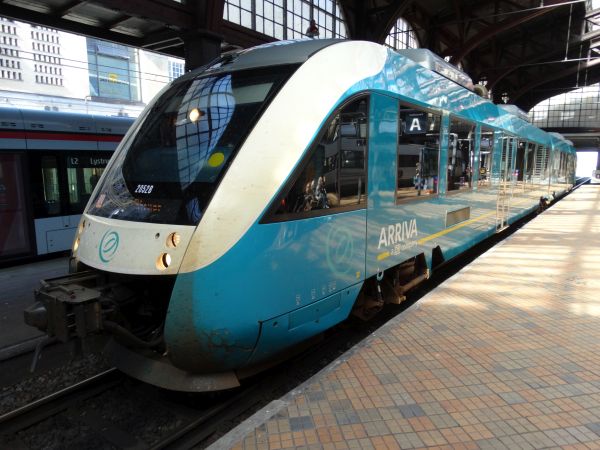
Yet another Lint train of Arriva.
Picture from Aarhus 8.7.2023 by Ilkka Siissalo.
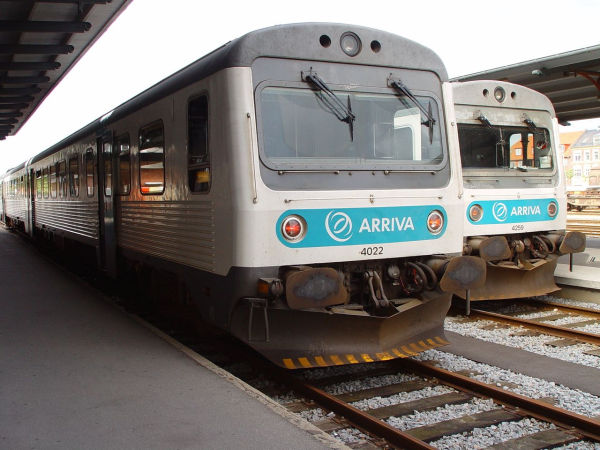
This picture is from those times when the company Arriva had fairly recently arrived in Denmark and was
still operating with old class MRD diesel railbuses rented from DSB.
Picture from Esbjerg 3.7.2004 by Ilkka Siissalo.
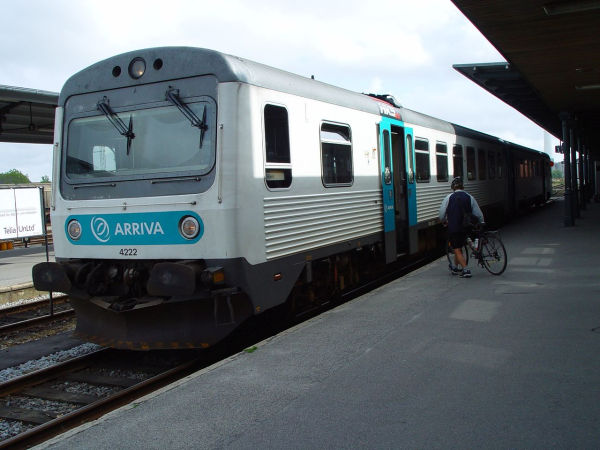
The old class MRDs were not very comfortable for bikers.
Picture from Esbjerg 3.7.2004 by Ilkka Siissalo.
Former Aalborg - Hadsund Jernbane
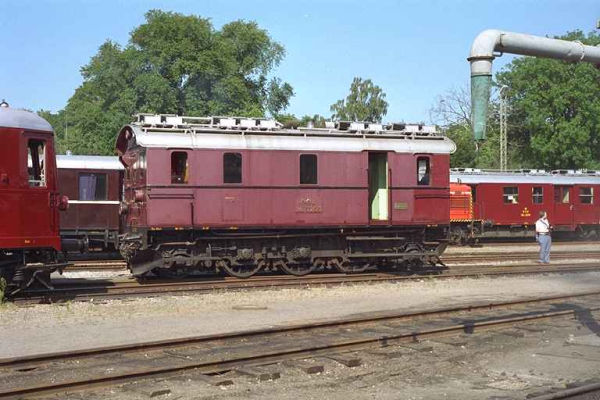
AHJ Ml 5203 locomotive 1'Co1' built in 1936 by Frichs in Aarhus.
The line from Aalborg to Hadsund closed in 1969.
Picture from the Railway Museums open day at Randers, Denmark, 12th August 1995.
Photo by Erik Hjelme.
Banestyrelsen
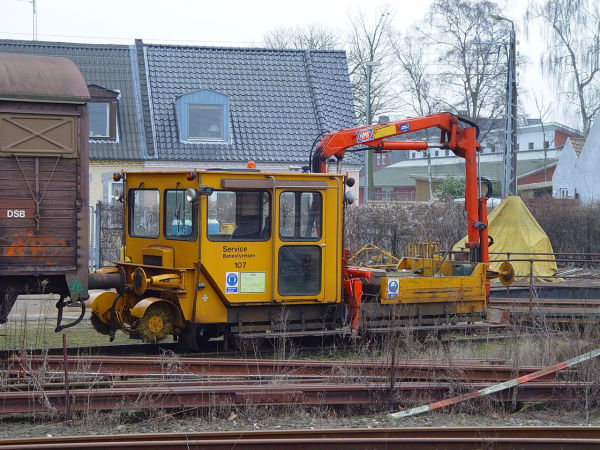
Banestyrelsen is not really exactly a private rail company, but rather the state authority that takes care of railroad
maintenance and ownership in Denmark. This little cute rail truck was photographed 2.3.2003 at Nykøbing station by Ilkka
Siissalo. Note the small rotating brushes used to clean tracks.
CFL cargo Danmark
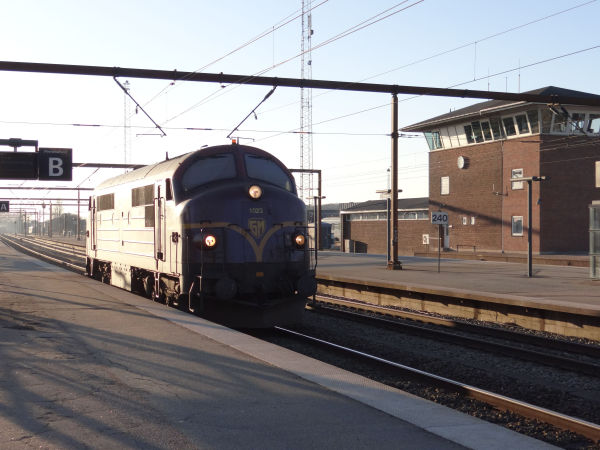
This is an old Nohab of the class MX built in 1961. It was for quite some time owned by the private rail company
ØSJS as their MX no.41, but it was in 2007 bought by CFL, the state railways of Luxembourg. CFL uses it now
to operate their own trains in Denmark. CFL is active in many other European countries in addition to its
home country. Here the locomotive is in full speed passing the train station of Odense on 13.3.2014.
Picture by Ilkka Siissalo.
Lokalbanen AS - Lokaltog AS
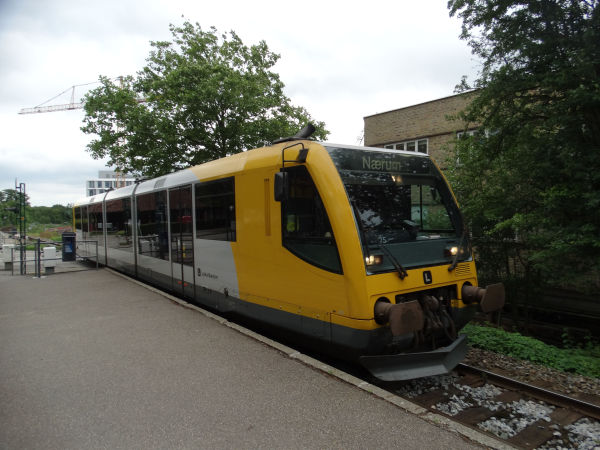
The German Siemens/Düwag type called Regiosprinter was designed as a diesel engine based "tram-train". Despite its
modern technology, they never became a commercial success. The biggest users in Germany are/were Rurtalbahn and Vogtlandbahn
and especially the last named company made real use of the models capabilities by operating these units as trams in the middle
of cities and as diesel multiple unit trains elsewhere. Many of the German Regiosprinters have by 2016 been sold to Austria an Czech Republic.
In Denmark the only user of the type is Nærumbanen (LNJ), which became a part of Lokalbanen AS. Since 2015 the company is called
Lokaltog AS after yet further fusions. They operate a fast, tram-like
light rail system in the suburbs of Copenhagen. This picture is from the train stop Lyngby lokal.
Picture 10.7.2016 by Ilkka Siissalo.
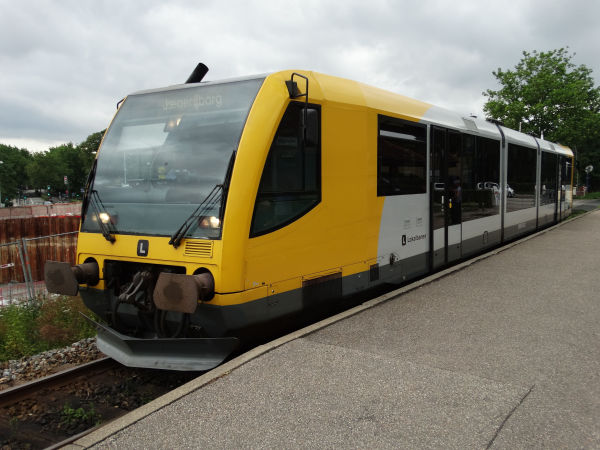
Another Regiosprinter arrived from the other direction to the train stop Lyngby lokal.
Picture 10.7.2016 by Ilkka Siissalo.
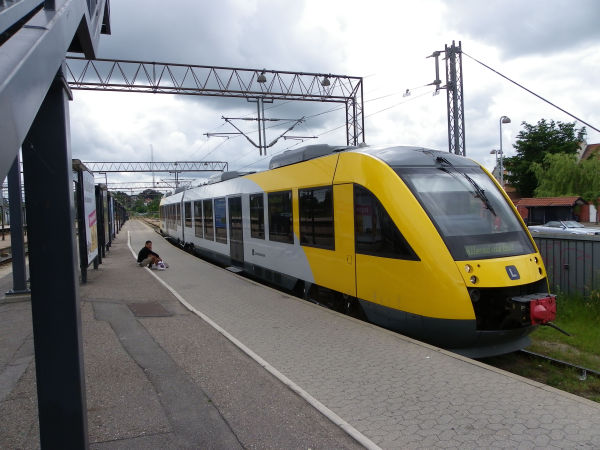
An Alstom Lint railbus at Helsingør station, ready to leave towards Hillerød. These modern railbuses replaced in many places in Denmark
the 1960s Lynette railbuses which once were so omnipotent in all private rail traffic.
Picture from Helsingør 30.6.2010 by Ilkka Siissalo.
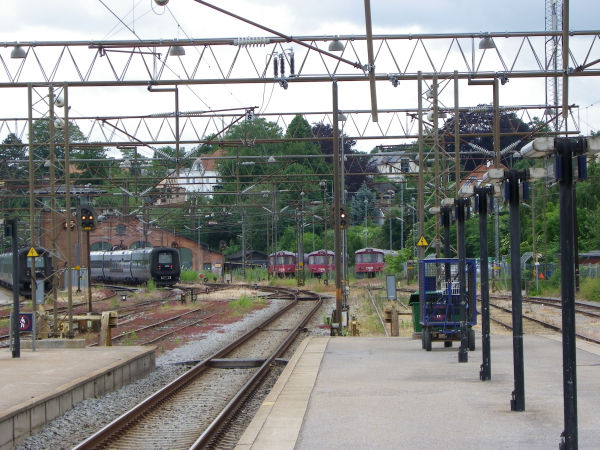
...And this was the view right behind the modern Lint railbus: Three DSB Lynette trains from the 1960s have been literally pushed
aside to the bushes by the new Lints. The line from Helsingør to Hillerød was the only one where the state railways DSB used
Lynettes, otherwise the Lynette trains were used only by the private rail companies - but all of them. And now with their new
trains the private company Lokalbanen pushed state DSB aside from the whole route.
Picture from Helsingør 30.6.2010 by Ilkka Siissalo.
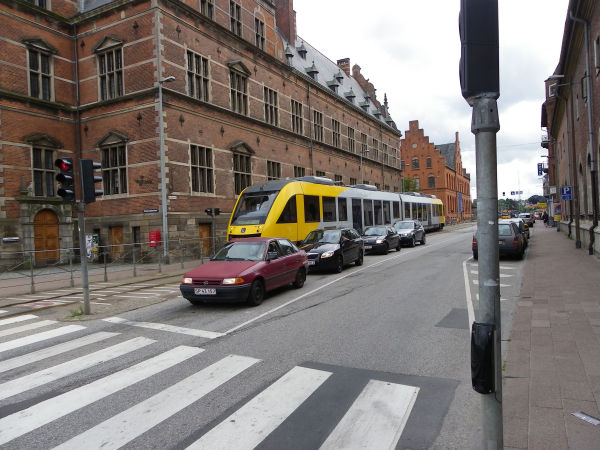
The private Lokalbanen Lint trains start their journey from the Helsingør station towards Gilleleje and Hillerød in the middle of normal
road traffic...
Picture from Helsingør 30.6.2010 by Ilkka Siissalo.
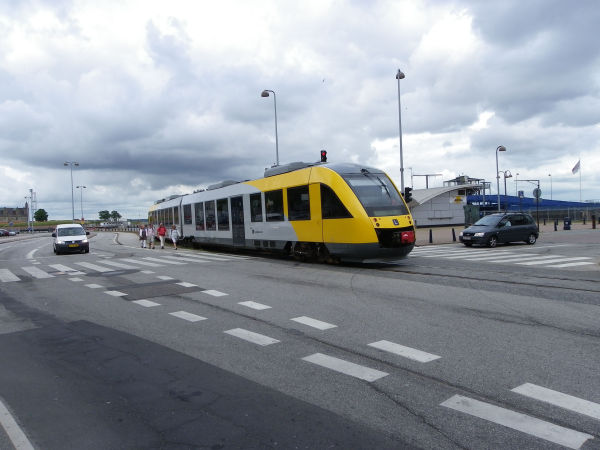
... the only difference being that the trains do not have to stop at red traffic lights, but cars will have to give way instead.
Picture from Helsingør 30.6.2010 by Ilkka Siissalo.

In 2004 the same route was still run by the 1960s Lynette trains and the rail company was called Helsingør-
Hornbæk-Gilleleje-Banen HHGB. That company later fused into Lokalbanen AS.
Picture from Gilleleje 2.7.2004 by Ilkka Siissalo.
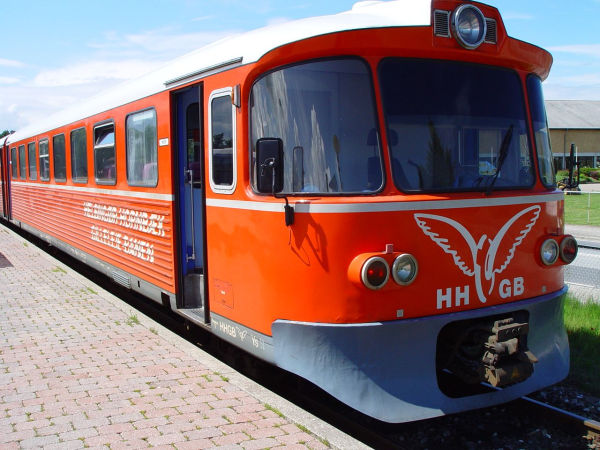
Another view of the same Lynette.
Picture from Gilleleje 2.7.2004 by Ilkka Siissalo.
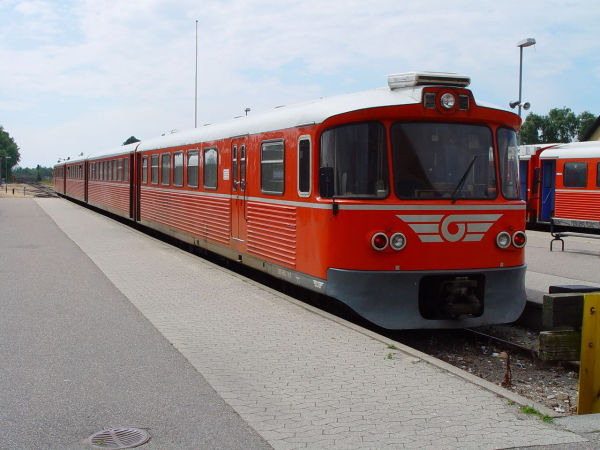
Two other private rail companies, Gribskovbanen and Hundested-Frederiksværk-Hillerød banen first fusioned into GDS-HFHJ
which then in turn became part of the present Lokalbanen. This picture from 2004 is from a time when Lokalbanen already
existed but the trains still had old markings of the GDS-HFHJ.
They were by then using four coach long Lynette trains on their service from Gilleleje to Gribskov.
Picture from Gilleleje 2.7.2004 by Ilkka Siissalo.
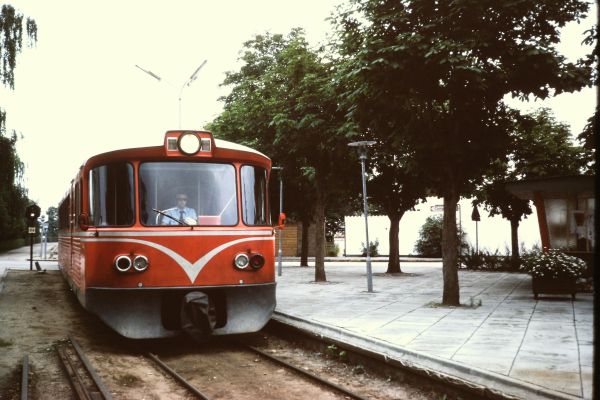
This is a picture from times a couple of private railroad fusions ago, from a time when HHGB did not yet exist. This is a
Lynette train, operating much like a diesel tram between the city of Helsingør and the village of Hornbæk as the
Helsingør -Hornbæk Banen (Hornbækbanen). This was later fused to become HHGB and so on...
Picture from somewhere close to Helsingør in 1978 by Adrian Gray.
Nordjyske Jernbaner
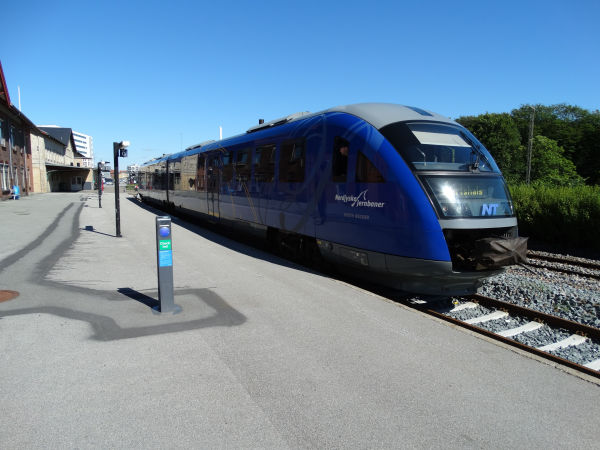
These by then almost new Siemens Desiro trains are operated by the Nordjyske Jernbaner in the very north of Jutland (Jylland)
peninsula, here in service between Hjørring and Hirtshals.
Picture from Hjørring 6.7.2016 by Ilkka Siissalo.
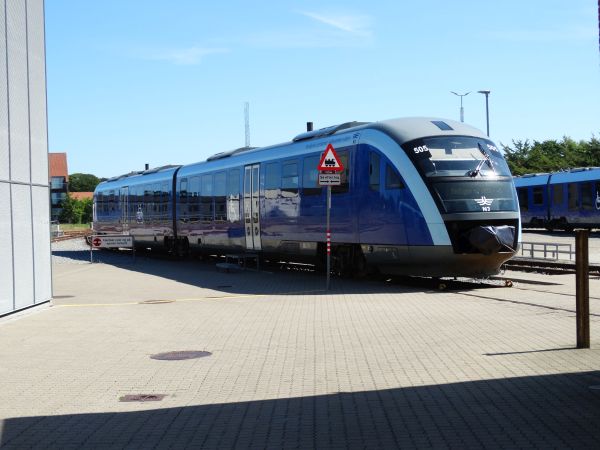
One of the same Siemens Desiro trains as above, but now in 2023 after a full revision. The painting scheme has changed somewhat.
Picture from Nordjyske Jernbaner's depot at Hjørring 8.7.2023 by Ilkka Siissalo.
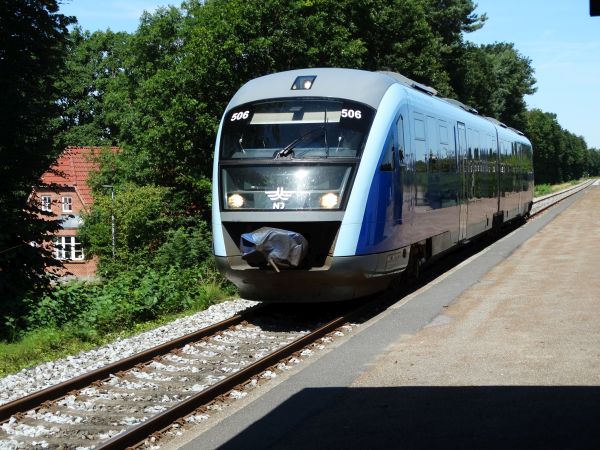
One of Nordjyske Jernbaner's Desiro trains approaching the station of Brønderslev.
Picture 8.7.2023 by Ilkka Siissalo.
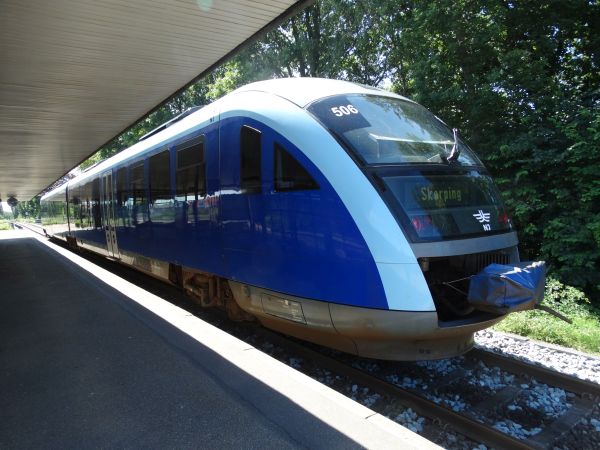
The same Desiro train as above, now stopping at Brønderslev.
Picture 8.7.2023 by Ilkka Siissalo.
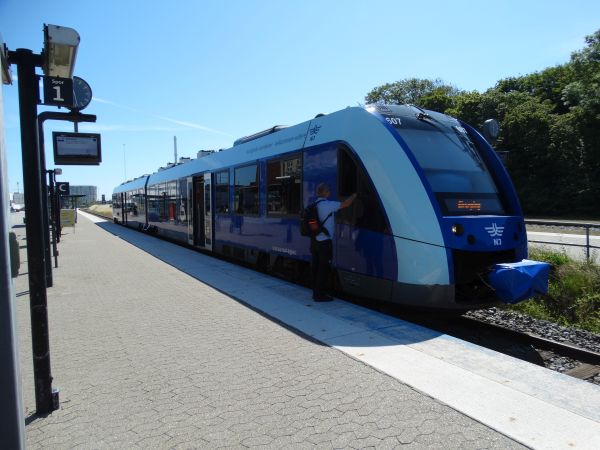
During the years the area covered by Nordjyske Jernbaner's services had drastically grown. The same Desiro trains as shown
above are still being used, but they are not enough for the present area to be covered. NJ ordered new trains and this time they were
no longer Siemens' Desiros but Lint trains of the French owned company Alstom. NJ ordered 8 Desiros during 2000-2004 and 13 of these Alstom
Lint 41 type trains in 2016. In 2021 four more Lint trains were ordered. Note also NJ's new logo.
Picture from Hjørring 8.7.2023 by Ilkka Siissalo.
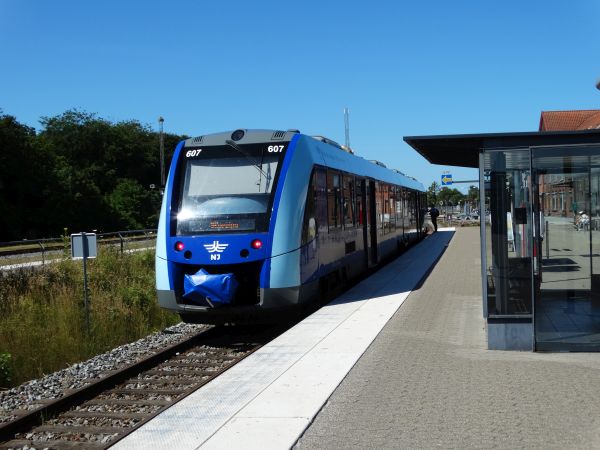
The same Lint train as shown above but now seen from the other direction.
Picture from Hjørring 8.7.2023 by Ilkka Siissalo.
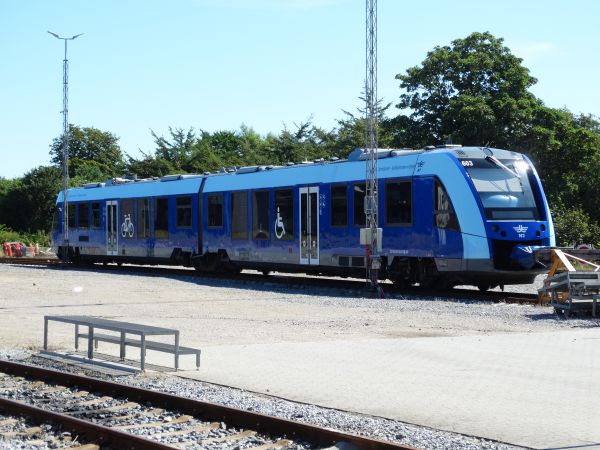
One more of the Alstom Lint type 41 trains.
Picture from the Nordjyske Jernbaner's depot at Hjørring 8.7.2023 by Ilkka Siissalo.
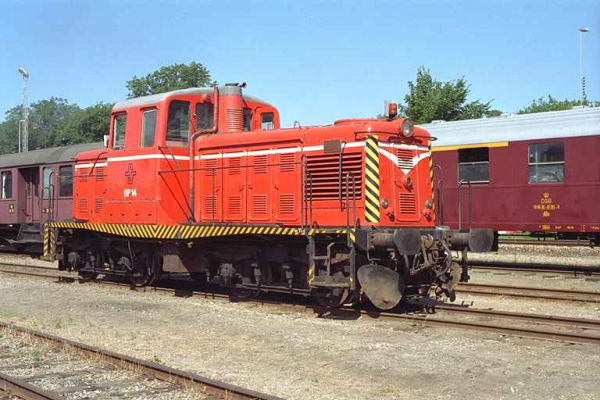
Hirtshalsbanen (now part of Nordjyske Jernbaner) between Hjørring and Hirtshals was once operated by this HP 14
built in 1953 by Frichs in Aarhus. Picture from Danish Railway Museum's open day at
Randers, Denmark 12 August 1995.
Photo by Erik Hjelme.

An old, valuable, museum railbus of the Düwag made type "Lynette", which was once used by all Danish private railroads, here in the
paintings of SB or Skagensbanen, now a part of Nordjyske Jernbaner, left to the mercy of vandals at Aalborg.
Picture from Aalborg 31.8.2016 by Ilkka Siissalo.
Midttrafik
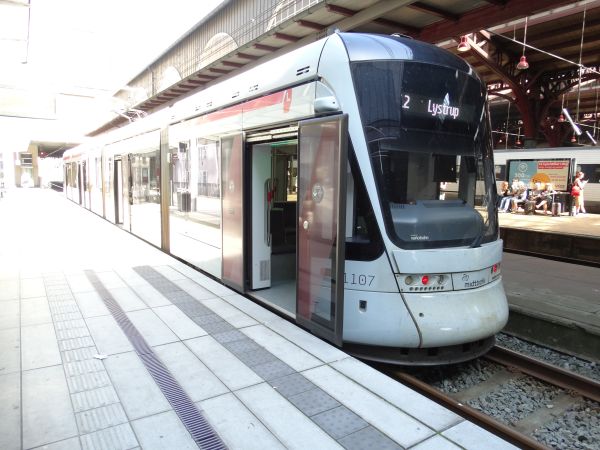
Midttrafik is a fairly new company which takes care of public transport in the central part of the Jutland peninsula. Midttrafik operates the
light rail / tram services of the city of Aarhus, owns the majority stake of Midtjyske Jernbaner (described below on this page) and runs the bus
services of Aarhus, Herning, Horsens, Randers, Silkeborg and Viborg cities/towns.
The Aarhus Letbane (Aarhus light rail) is a light rail system that runs on train rails, but isolated from the state owned DSB's network. Service
is run by these Stadler Variobahn trams on 1435 mm gauge but with just 750V DC electricity. Top speed is 70 km/h. This is the so called phase 1
service of Aarhus Letbane, which is just a single line from the Aarhus H station to Lystrup.
Picture from the station Aarhus H 8.7.2023 by Ilkka Siissalo.
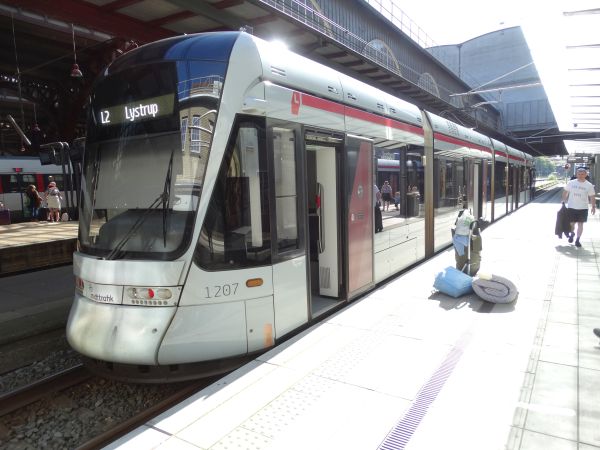
Another view of one of the Stadler Variobahn tram-trains.
Picture from the station Aarhus H 8.7.2023 by Ilkka Siissalo.
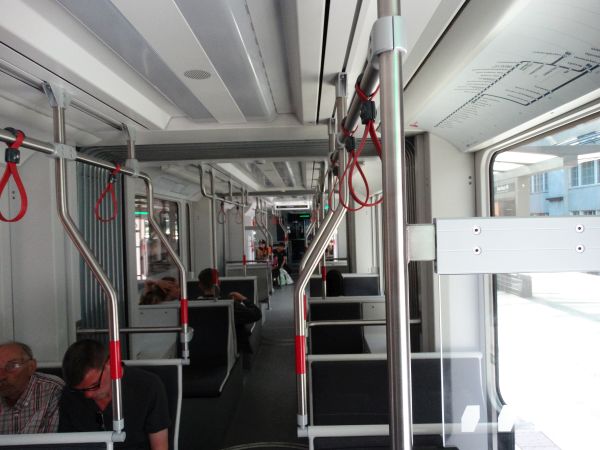
Inside view of one of the Stadler Variobahn tram-trains.
Picture from the station Aarhus H 8.7.2023 by Ilkka Siissalo.
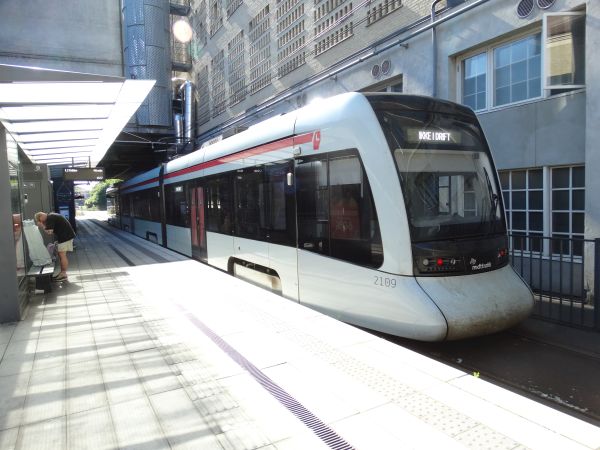
The Aarhus light rail system operated by Midttrafik has two kinds of tram-trains. Both are two direction trains with doors on both sides.
The Variobahn trains shown above are intended for the more citylike
traffic with frequent stops and lower speeds whereas the Stadler Tango trains can reach a higher speed and are intended for the longer routes. This is
a Stadler Tango light rail train. Midttrafik uses these between Grenaa and Aarhus H.
Picture from the station Aarhus H 8.7.2023 by Ilkka Siissalo.
Odderbanen / Hads-Ning Herreders Jernbane HHJ / Midtjyske Jernbaner
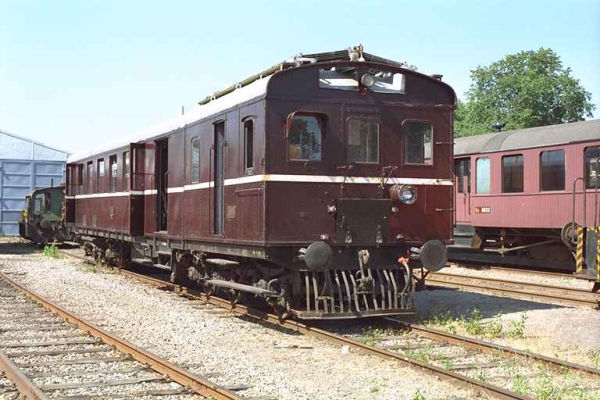
HHJ M2 built in 1932 3'(A1A)' by Frichs in Aarhus. Picture from the Danish Railway Museums open day
at Randers, Denmark 12 August 1995. This old railcar is from the so called
Odderbanen in Jutland (Jylland).
Photo by Erik Hjelme.
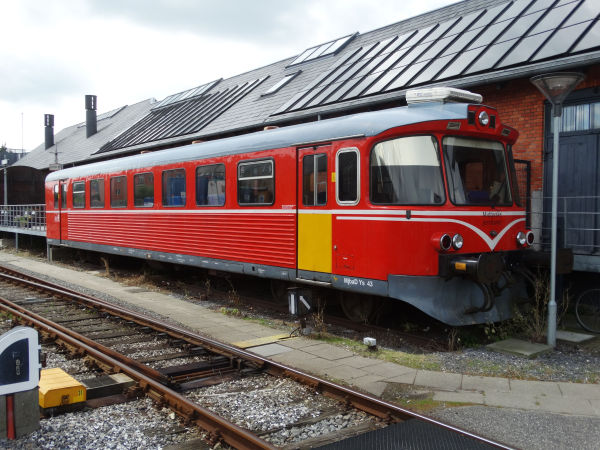
After the huge diesels and heavy M2 railcars, during 1960s to 1990s all traffic on most private railroads was taken care by the
so called Lynette light railbuses. This is one car out of a three car Lynette set. During this period
the train company at Odderbanen had changed its name to Midtjyske Jernbaner. These red Lynettes were locally
known by the nickname Oddergrisen, piglet of Odder.
Picture from Horsens 8.7.2016 by Ilkka Siissalo.
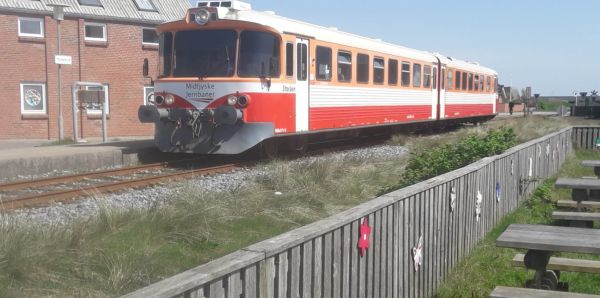
Midtjyske jernbaner is the last Danish train operator which still uses old Lynette trains from the 1960s, but they also have taken
over some newer Desiro trains from DSB. This two wagons long Lynette was photographed by Teppo Niemi in Thyborøn 3.5.2024.
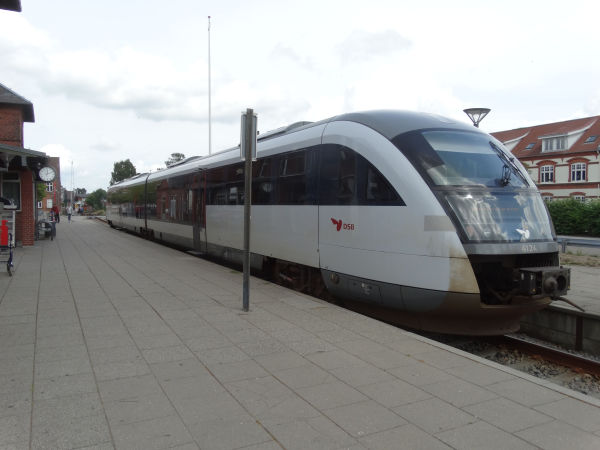
In 2012 the traffic on Odderbanen Odder-Aarhus became part of Aarhus Nærbane and the new operator became to
be DSB. This is a DSB Desiro railbus, operating in 2016 on the line. From beginning of 2017 however,
there was again to be a change. The line became a part of Aarhus Letbane, a light rail system running as a tram
in city centers and as a train in the countryside. New rolling stock are trams made by Stadler.
Picture from Horsens 8.7.2016 by Ilkka Siissalo.
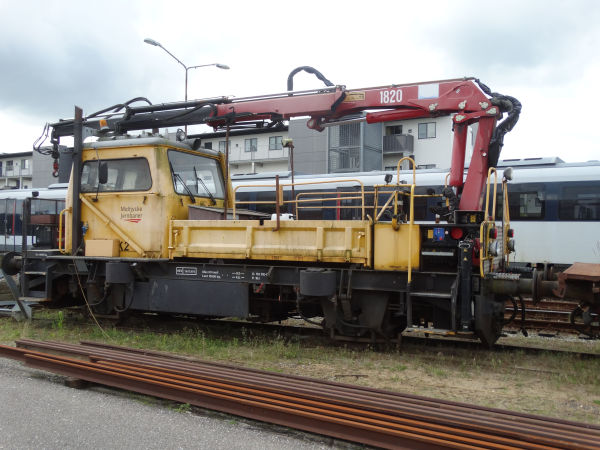
Although the operator was DSB, Midtjyske Jernbaner still took care of the track maintenance in 2016. An MJ
rail truck at Horsens 8.7.2016.
Picture by Ilkka Siissalo.
OHJ Odsherredsbanen
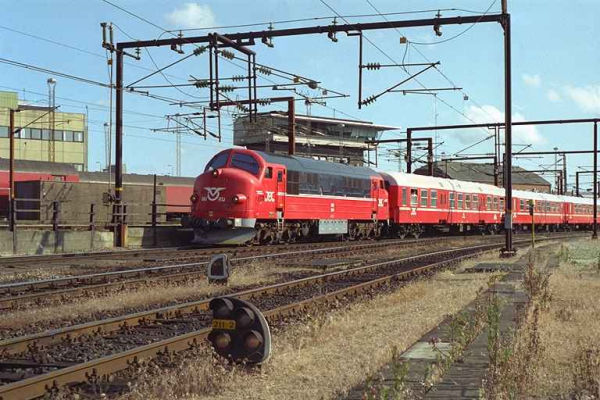
OHJ's class MX Nohab no. 104 (A1A)'(A1A)' locomotive GM 567c-12.
This locomotive was bought from DSB by the privately
(read local council) operated line "Odsherredsbanen" running from
Holbæk to Nykøbing and is here seen arriving at Copenhagen
Central station in the afternoon of 2nd July 1995.
The companies OHJ and HTJ merged in 2003. Then the new company OHJ HTJ merged in
2009 with Lollandsbanen A/S and Østbanen to become Regionstog (see below) which then
in turn in 2015 merged with Lokalbanen AS (see above) to become Lokaltog AS.
Photo by Erik Hjelme.
Railcare Danmark
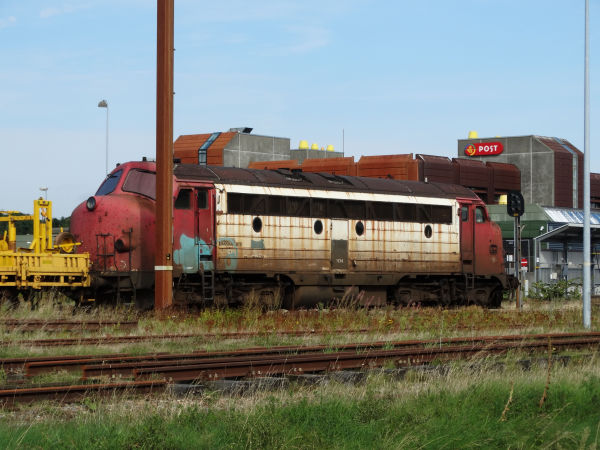
Poor old locomotive ! This class MY (Sweden: TMY) no. 1134 Nohab was built in 1957. We have followed its
fate already earlier, as it can be seen in our category Sweden -> private operators' locomotives.
Then in 2009, it was still more or less in good shape. It was sold 2010 back to Denmark where it originated
from, to Railcare Danmark, who then proceeded to rent it to Captrain, a French company. Here apparently
it is back to Railcare, but in a desolate condition.
Picture from Aalborg 31.8.2016 by Ilkka Siissalo.
Regionstog RT (since 2015 a part of Lokaltog AS)
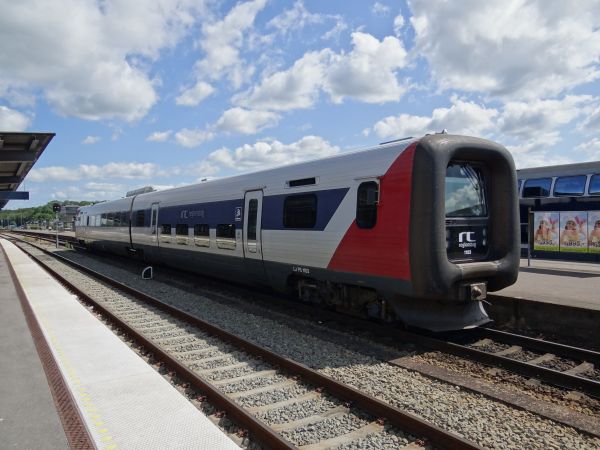
Regionstog was a company which was a fusion product
of several earlier private rail companies. This "rubbernose" of class IC2 is seen here at Nykøbing 11.7.2013
ready to leave towards Nakskov on the so called Lollandsbanen. State railways DSB has also a train
called IC2, but that is a totally different one.
Picture by Ilkka Siissalo.
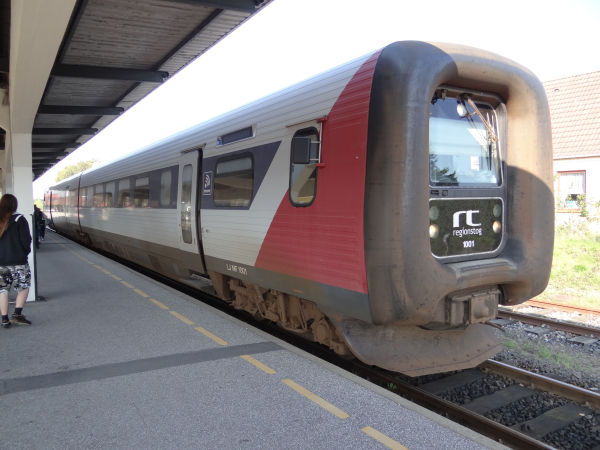
What used to be LJ Lollandsbanen, a private railroad between Nykøbing (Falster) to Nakskov, was a
part of the RT Regionstog A/S at the time when this photo was taken. This is a Regionstog IC2 which has just stopped
at the Maribo station and is now opening its doors while passengers are waiting. These "rubberface" trains are essentially the same as
the ones used for example in Sweden in their "Kustpilen" service, but these also have a small low-floor
section. (Note that DSB had in Denmark also Italian built trains called IC2, but they have nothing to do
with these private IC2s. Yes, it is confusing.)
Picture from Maribo station 19.9.2014 by Ilkka Siissalo.
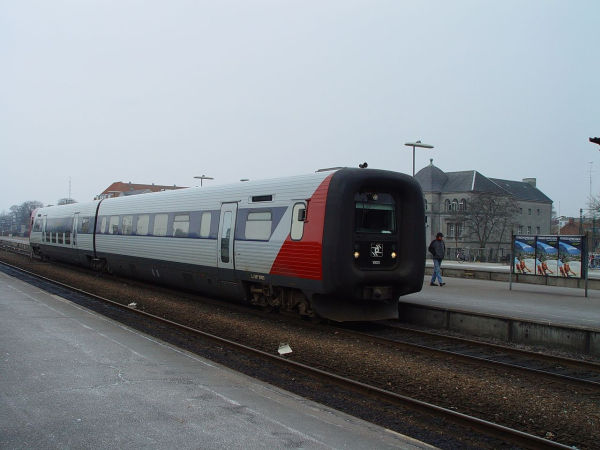
One of the same IC2 trains, but here still with the old Lollandsbanen logo on its front in 2003.
Picture from Nykøbing (Falster) station 2.3.2003 by Ilkka Siissalo.

Same train as above, but seen from the other direction. Note the low-floor section.
Picture from Nykøbing (Falster) station 2.3.2003 by Ilkka Siissalo.
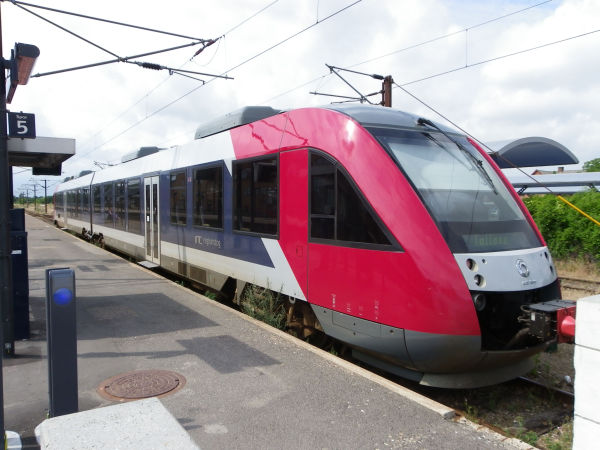
An Alstom LINT diesel railbus of Regionstog at Korsør station waiting to leave to Tølløse.
Picture from Korsør 22.7.2010 by Ilkka Siissalo.
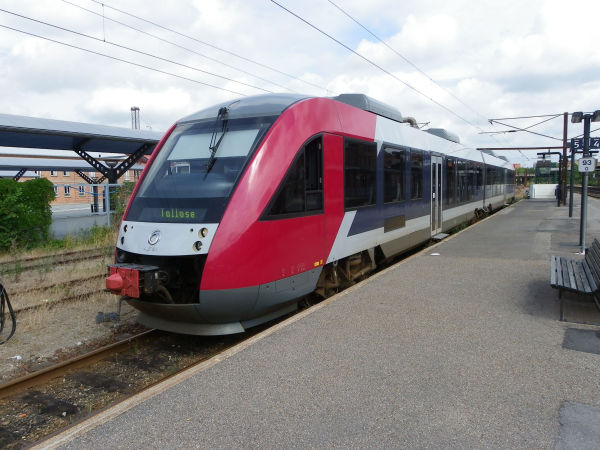
Another view of the same LINT as above.
Picture from Korsør 22.7.2010 by Ilkka Siissalo.
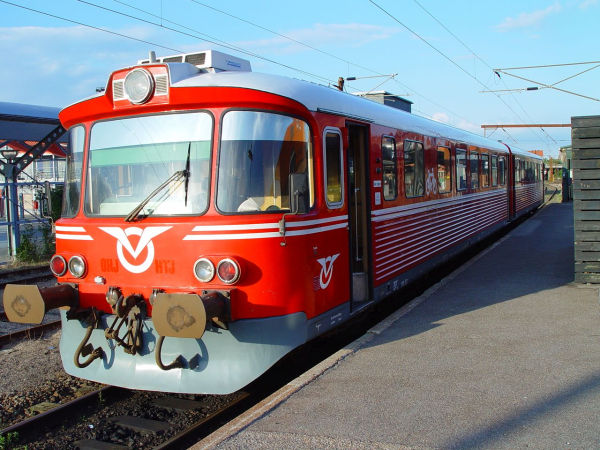
These were the trains used on the same line before the time of the LINTs shown above: An old two coach
Lynette railbus still with the OHJ-HTJ stickers. The companies OHJ and HTJ merged in 2003. Then the new company OHJ HTJ merged in
2009 with Lollandsbanen A/S and Østbanen to become Regionstog which then
in turn in 2015 merged with Lokalbanen AS to become Lokaltog AS. This picture is from 2004, so the company was still
OHJ HTJ.
Picture from Slagelse 2.7.2004 by Ilkka Siissalo.
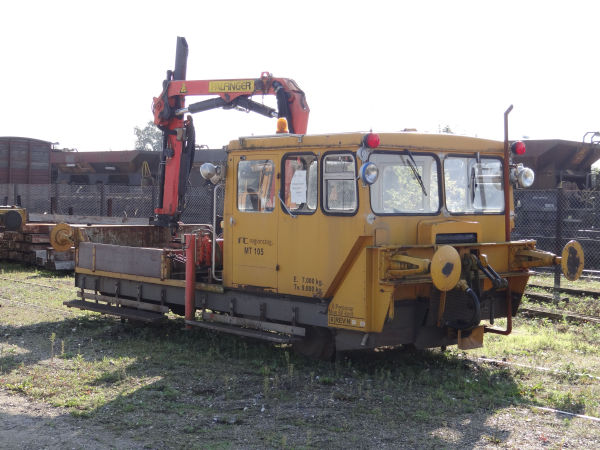
Rail truck MT 105 of Regionstog.
Picture from Maribo station 19.9.2014 by Ilkka Siissalo.
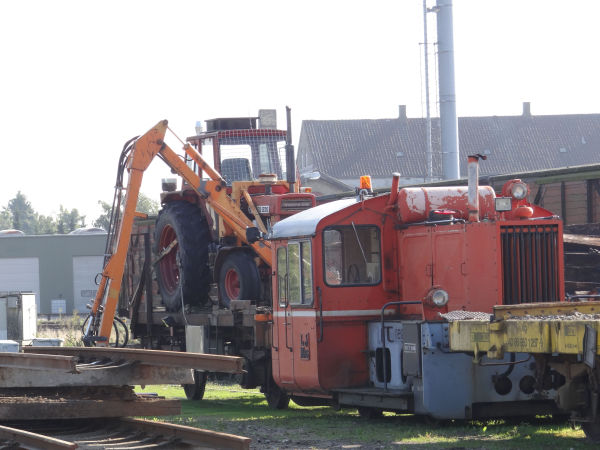
A rather strange combination of an old Köf II locomotive and a tractor fixed on top of a cargo wagon
makes up for ad hoc machinery for exchanging rails. These are all Regionstog's equipment.
Picture from Maribo station 19.9.2014 by Ilkka Siissalo.
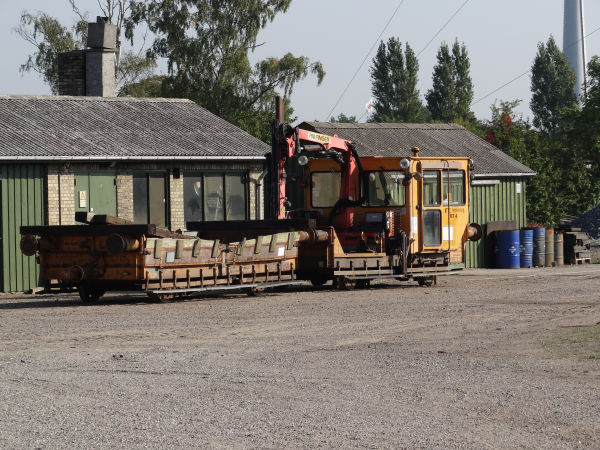
A bit more modern rail truck of Regionstog, this MT 4 was used for picking up old rotten sleepers and
transporting them away.
Picture from Maribo station 19.9.2014 by Ilkka Siissalo.
Skagensbanen SB
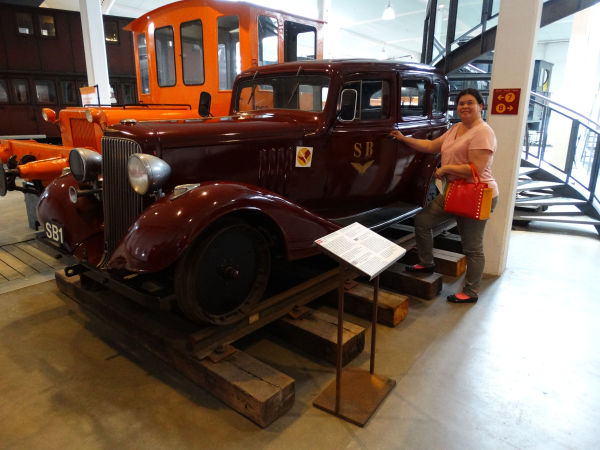
This luxurious Pontiac rail car of Skagensbanen was intended for the use of Skagensbanen's top management.
Train photographer Sanna Siissalo is admiring the car, which is from the year 1934. Skagensbanen bought it in 1944.
During the period of the Nazi German invasion, no gasoline was available and during that time the car was fitted with
a wood gas generator.
Picture from the Danish national railway museum in Odense 10.7.2016 by Ilkka Siissalo.
Syd Fyenske Veteranjernbane, Korinth - Faaborg
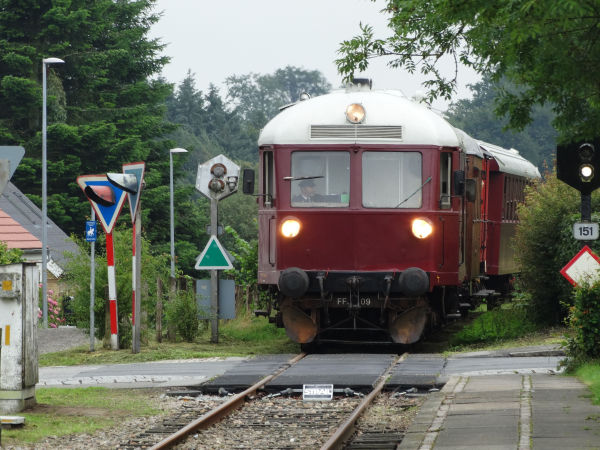
The Syd Fyenske Veteranjernbane is an association, which during summer weekends operates museum trains
on the Faaborg - Korinth line. The trains consist of rolling stock from both DSB and from various former
private rail companies.
Here the Syd Fyenske Veteranjernbaner train is approaching Korinth station 10.7.2016. Picture by Ilkka Siissalo.
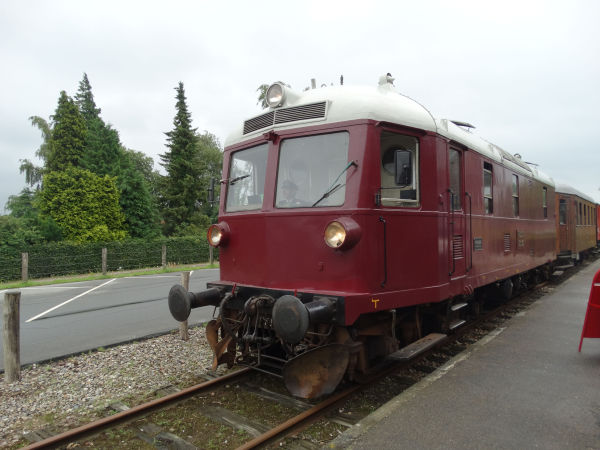
... and then it stops at the Korinth station. A pure 1950s private train.
Picture 10.7.2016 in Korinth by Ilkka Siissalo.
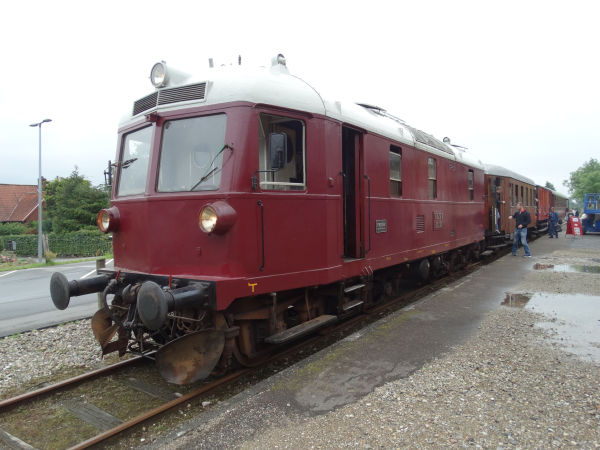
The impressive 6 axle locomotive class ML no.12 made by Frichs was earlier used as a type by several private railroads before the time of
the cheap and lightweight Lynette railbuses. This one used to belong to VLTJ or Lemvigbanen, later part of the
Midtjyske Jernbaner.
Picture 10.7.2016 in Korinth by Ilkka Siissalo.
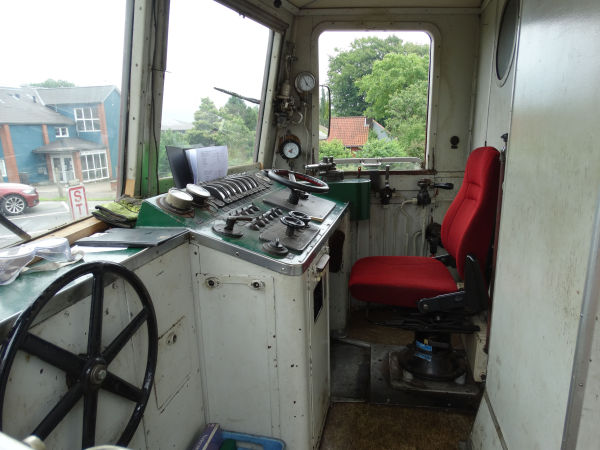
Driver's cab of the old Frichs class ML locomotive. It's all old, except for the driver's chair.
Picture 10.7.2016 in Korinth by Ilkka Siissalo.
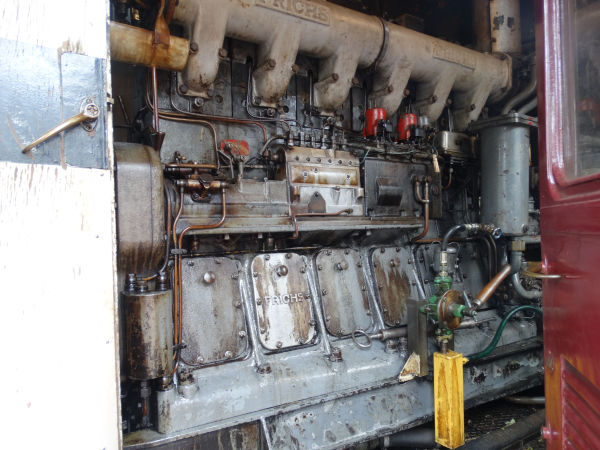
The mighty and noisy old diesel engine of the class ML locomotive.
Picture 10.7.2016 in Korinth by Ilkka Siissalo.
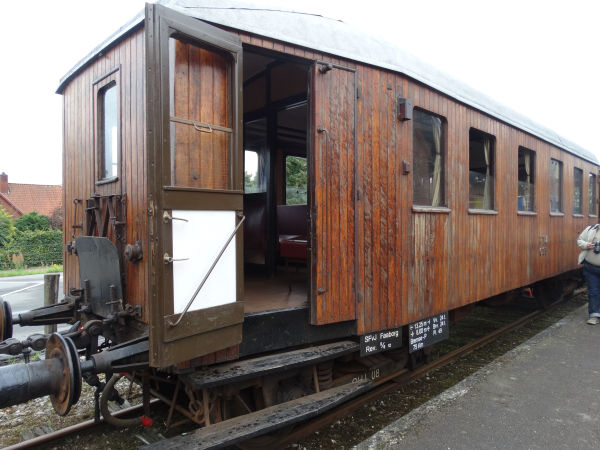
This old teakwood coach originates from the company HTJ, Høng - Tølløse Jernbane.
Picture 10.7.2016 in Korinth by Ilkka Siissalo.

Inside view of the old HTJ, Høng - Tølløse Jernbane, wagon.
Picture 10.7.2016 in Korinth by Ilkka Siissalo.
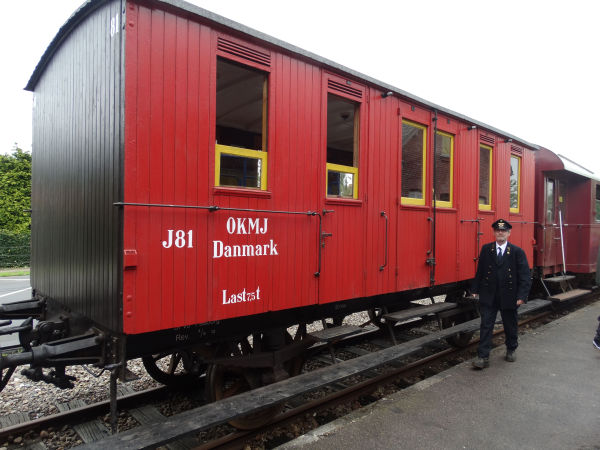
This old wagon of the museum train originates from OKMJ, Odense-Kerteminde-Martofte Jernbane.
Picture 10.7.2016 in Korinth by Ilkka Siissalo.
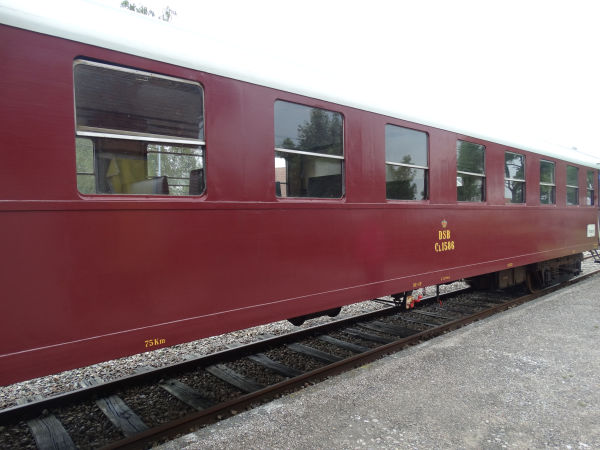
And last but not least, the train consisted of also one DSB coach of the class CL. It looks almost new, but the bogies are taken
from a much, much older coach and date back to the year 1839.
Picture 10.7.2016 in Korinth by Ilkka Siissalo.
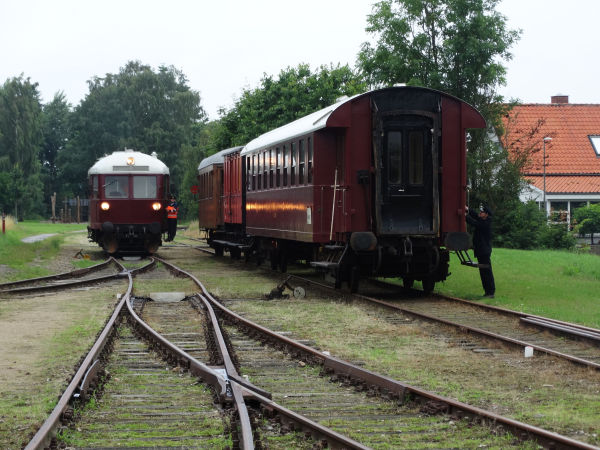
Here is still once more the whole museum train, while the locomotive was being moved to the other end.
Picture 10.7.2016 in Korinth by Ilkka Siissalo.
Århus - Hammel - Thorsø Jernbane ÅHTJ
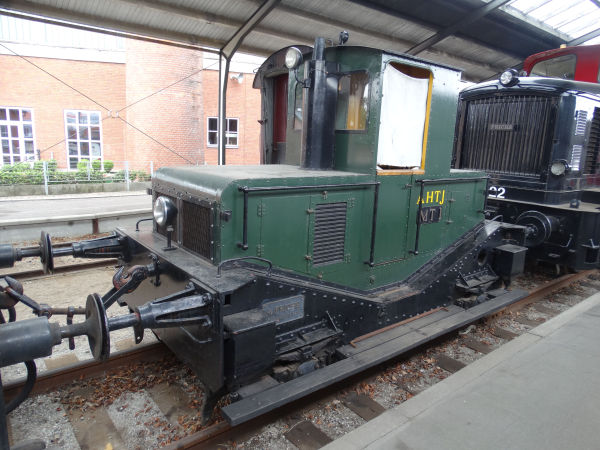
This ÅHTJ rail tractor was built by Frichs in 1933. It had a Frichs six cylinder diesel engine. It changed ownership
several times and was finally delivered to the national railway museum in Odense in 2005, where this picture was taken
10.7.2016 by Ilkka Siissalo.
Øresundståg - DSB Øresund - former DSBFirst
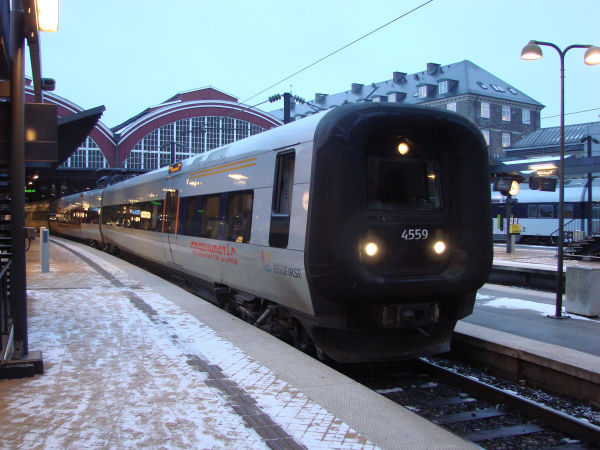
After the Øresund bridge and tunnel created a fixed rail connection between Denmark and Sweden, a joint venture
company, DSBFirst, was set up. Danish state DSB owned a part of it and the First bank a part. First bank later backed out
of the operations, which are now run by DSB Øresund and Transdev. Øresundståg operates with electric "rubberface" trains
known as IC3, in Sweden called X31. There are today Øresundståg trains which are only allowed to run inside Sweden
and then also versions which may be used both in Sweden and in Denmark.
Picture of an Øresund train at Copenhagen central station 12.1.2010 by Ilkka Siissalo.
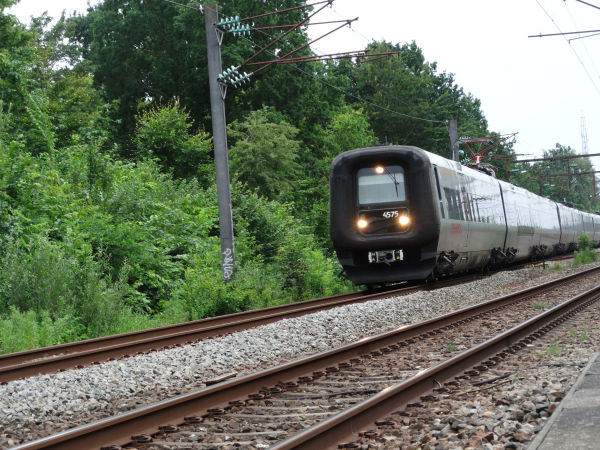
One of the Øresundståg units in full speed at Nivå, north of Copenhagen.
Picture 10.7.2016 by Ilkka Siissalo.
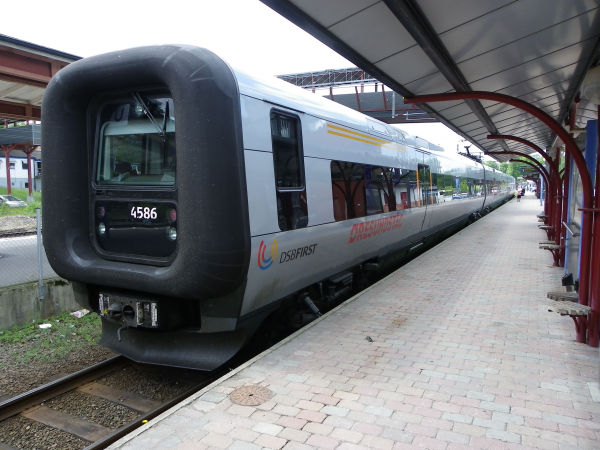
One of the Øresundståg units in Växjö, Sweden.
Picture 30.6.2010 by Ilkka Siissalo.


